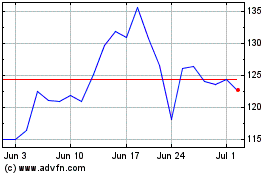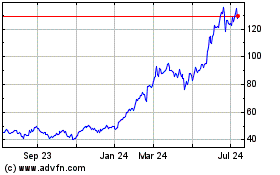Nvidia Has to Play This Game Perfectly -- Heard on the Street
September 03 2020 - 7:29AM
Dow Jones News
By Dan Gallagher
The phrase "this time is different" can be a dangerous one in
business. Fortunately for Nvidia Corp., it also appears to be
accurate.
The chipmaker's last major product cycle for its graphics
processors designed for videogaming was a letdown. The performance
upgrade for the company's Turing family was considered
disappointing relative to the previous cycle's boost -- especially
at the higher prices Nvidia was demanding. And relatively few games
at the time were using the ray-tracing technology that was the key
feature of the Turing line.
To make matters worse, that upgrade came right around the
popping of the cryptocurrency bubble in which "miners" were
snapping up Nvidia's chips to handle the complex equations that are
used to generate new units of currencies such as etherium. That
inflated sales in the few quarters before the first Turing chips
hit the market in late 2018, then hurt sales when miners later
dumped those chips on the secondary market.
The experience proved costly in a couple ways. Nvidia's gaming
revenue fell for four straight quarters following the launch, and
its highflying stock shed more than half its value during the last
three months of the year.
The road looks clearer for the company's newest gaming chips
announced earlier this week.
The new family, known as Ampere, offers twice the computing
performance of the previous generation, and many more games in the
ecosystem have adopted ray-tracing -- including the blockbuster
"Fortnite." Nvidia also kept the pricing down on the newest
generation. Deutsche Bank analyst Ross Seymore notes that the
midrange $500 version of the newest Ampere line offers the same
performance as the $1,000 version of the Turing lineup. And this
time, there is no crypto-bubble to thwart the supply chain and skew
comparisons.
That has led Nvidia to project record videogame-related revenue
for its fiscal third quarter ending in October. The forecast calls
for a 25% jump from the second quarter, which would amount to a
little over $2 billion in revenue for that segment. Analysts expect
Nvidia's gaming revenue to surge 28% for the full fiscal year
ending in January. Some of that will come from the growing sales of
the popular Nintendo Switch console, which uses a central processor
from Nvidia. But the Ampere chips are expected to be the main
driver, with Stacy Rasgon of Bernstein predicting a "monster gaming
cycle" for Nvidia.
Nvidia can afford nothing less. The company's data-center
business has grown quickly and made the company a darling on Wall
Street, but videogaming remains the company's largest segment,
accounting for 47% of its total revenue for the trailing 12-month
period ended July. The stock had already surged 127% for the year
before its gaming announcement early Tuesday and has picked up
another 7% since. That has made Nvidia the second-largest company
on the PHLX Semiconductor Index by market value, giving the
never-cheap stock a multiple of 58 times forward earnings -- 55%
above its valuation ahead of the last gaming cycle.
At this level, another gaming reset would be painful.
Write to Dan Gallagher at dan.gallagher@wsj.com
(END) Dow Jones Newswires
September 03, 2020 07:14 ET (11:14 GMT)
Copyright (c) 2020 Dow Jones & Company, Inc.
NVIDIA (NASDAQ:NVDA)
Historical Stock Chart
From Mar 2024 to Apr 2024

NVIDIA (NASDAQ:NVDA)
Historical Stock Chart
From Apr 2023 to Apr 2024
